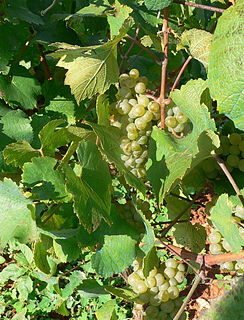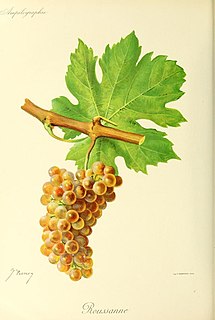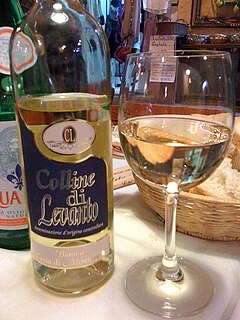Related Research Articles

Malvasia is a group of wine grape varieties grown historically in the Mediterranean region, Balearic Islands, Canary Islands and the island of Madeira, but now grown in many of the winemaking regions of the world. In the past, the names Malvasia, Malvazia, and Malmsey have been used interchangeably for Malvasia-based wines; however, in modern oenology, "Malmsey" is now used almost exclusively for a sweet variety of Madeira wine made from the Malvasia grape. Grape varieties in this family include Malvasia bianca, Malvasia di Schierano, Malvasia negra, Malvasia nera, Malvasia nera di Brindisi, Malvasia di Candia aromatica, Malvasia odorosissima, and a number of other varieties.

Roussanne is a white wine grape grown originally in the Rhône wine region in France, where it is often blended with Marsanne. It is the only other white variety, besides Marsanne, allowed in the northern Rhône appellations of Crozes-Hermitage AOC, Hermitage AOC and Saint-Joseph AOC. In the southern Rhône appellation of Châteauneuf-du-Pape AOC it is one of six white grapes allowed, where it may be blended into red wines. Roussanne is also planted in various wine-growing regions of the New World, such as California, Washington, Texas, South Africa and Australia as well as European regions such as Crete, Tuscany and Spain.

Nebbiolo is an Italian red wine grape variety predominantly associated with its native Piedmont region, where it makes the Denominazione di Origine Controllata e Garantita (DOCG) wines of Barolo, Barbaresco, Roero, Gattinara, Carema and Ghemme. Nebbiolo is thought to derive its name from the Italian nebbia or Piedmontese nebia, meaning "fog". During harvest, which generally takes place late in October, a deep, intense fog sets into the Langhe region where many Nebbiolo vineyards are located. Alternative explanations refers to the fog-like glaucous veil that forms over the berries as they reach maturity, or that perhaps the name is derived instead from the Italian word nobile, meaning noble. Nebbiolo produces lightly-colored red wines which can be highly tannic in youth with scents of tar and roses. As they age, the wines take on a characteristic brick-orange hue at the rim of the glass and mature to reveal other aromas and flavors such as violets, tar, wild herbs, cherries, raspberries, truffles, tobacco, and prunes. Nebbiolo wines can require years of aging to balance the tannins with other characteristics.

The Langhe is a hilly area to the south and east of the river Tanaro in the province of Cuneo and in the province of Asti in Piedmont, northern Italy.

Vermentino is a light-skinned wine grape variety, primarily found in Italian wine. It is widely planted in both in Sardinia and Liguria, to some extent in Corsica, in Piedmont under the name Favorita, and in increasing amounts in Languedoc-Roussillon. The leaves are dark green and pentagonal. The grapes are amber-yellow and hang in pyramidal bunches. The vines are often grown on slopes facing the sea where they can benefit from the additional reflected light. The Vitis International Variety Catalogue now gives Italy as its origin.
Freisa is a red Italian wine grape variety grown in the Piedmont region of north-west Italy, primarily in Monferrato and in the Langhe, but also further north in the provinces of Turin and Biella. Freisa is a vigorous and productive vine whose round, blue-black grapes are harvested in early October. The three-lobed leaves are relatively small and the bunches are elongated in form. By the 1880s it had become one of the major Piedmontese grapes, and in that period its cultivation was stimulated by the vine’s resistance to the downy mildew caused by the Plasmopara viticola fungus. Wines made from the Freisa grape are red and usually somewhat sweet and lightly sparkling, or foaming. Still and fully sparkling versions are also produced, however, as are dry and more decidedly sweet styles. In the Canavese there is also a rosé which can be made primarily from Freisa according to Denominazione di origine controllata (DOC) regulations.

Roero is a geographical area in the north-east corner of the province of Cuneo in Piedmont, north-west Italy. This hilly region is known for its wines and for its fruit production: particularly the peaches of Canale and the local variety of pear known as Madernassa which originated in the late eighteenth century in Vezza d'Alba. Strawberries are also grown.

Aleatico is a red Italian wine grape variety. It is notable for being the primary grape in the cult wine Aleatico di Portoferraio made in Elba. In Chile is known as Red Moscatel. The grape has also been cultivated at Mudgee in New South Wales and California.
Bonarda Piemontese, now officially listed simply as Bonarda but also known as Bonarda di Chieri and Bonarda del Monferrato is a red Italian wine grape variety that is grown in the northwestern region of Piedmont. Prior to the phylloxera epidemic of the 19th century, Bonarda was speculated to have accounted for 30% of the plantings in Piedmont but today is only found in scattered plantings along the left bank of the Tanaro river near Govone. In the mid-1990s, the grape experienced a slight revival as Piedmontese producers sought to add more aromatics to their Barbera wines by blending in Bonarda.
Braquet is a red French wine grape variety grown predominantly in the Provence region of southeastern France, particularly in the Bellet Appellation d'origine contrôlée (AOC) where it is as both a blending and varietal grape in still and rosé wines. Also known as Brachet, the vine produces naturally low yields and light bodied wines that are delicately perfumed. Recent thought among ampelographers is that Braquet is not related to the more aromatic Italian wine grape of the Piedmont region known as Brachetto.
Cortese is a white Italian wine grape variety predominantly grown in the southeastern regions of Piedmont in the provinces of Alessandria and Asti. It is the primary grape of the Denominazione di origine controllata (DOC) wines of Cortese dell'Alto Monferrato and Colli Tortonesi as well as the Denominazione di Origine Controllata e Garantita (DOCG) wine of Cortese di Gavi. Significant plantings of Cortese can also be found in the Lombardy region of Oltrepò Pavese and in the DOC white blends of the Veneto wine region of Bianco di Custoza. Cortese has a long history in Italian viticulture with written documentation naming the grape among the plantings in a Piedmontese vineyard as early as 1659. The grape's moderate acidity and light flavors has made it a favorite for the restaurants in nearby Genoa as a wine pairing with the local seafood caught off the Ligurian coast.

Piemonte wine is the range of Italian wines made in the region of Piedmont in the northwestern corner of Italy. The best-known wines from the region include Barolo and Barbaresco. They are made from the Nebbiolo grape. These wines are ideal for storage and a well-aged Barolo for instance may leave a feeling of drinking velvet because the tannins are polished and integrated more and more into the wine. As the wine matures the colour becomes more brownish and rust-red.

Arneis is a white Italian wine grape variety originating from Piedmont, Italy. It is most commonly found in the hills of the Roero, northwest of Alba, where it is part of the white Denominazione di Origine Controllata e Garantita (DOCG) wines of Roero. It can also be used to produce DOC wines in Langhe. Arneis is so called because it is regarded as a somewhat difficult variety to grow. It is a crisp and floral varietal, and has been grown for centuries in the region. The white wines made from the Arneis grape tend to be dry and full bodied with notes of pears and apricots.
Erbaluce or Erbaluce bianca is a white Italian wine grape grown primarily in the Piedmont region around Caluso, in Canavese. In addition to dry table wines, it is used to make sweet wines with deep golden coloring, such as passito. The grape has a long history in the Piedmont region, with the first written record dating to 1606, and most likely originated in the alpine hills of northern Piedmont.

Pigato is a white Italian wine grape planted primarily in Liguria. The grape is found in the Riviera di Ponente zone in Italy's region of Liguria which makes sturdy, aromatic wines with plenty of fruit. DNA evidence proves that Pigato, Vermentino and Favorita are the same variety. All sorts of theories exist about its origins: it could be Greek, or brought by the Romans from central Italy, or be related to Arneis or Vermentino; it is often confused with the latter. It gains its name, which means "spotted" from the appearance of the ripe grapes.
Vespolina is a red Italian wine grape variety that is planted in Piedmont around Gattinara and Ghemme. Ampelographer believe that the grape is most likely indigenous to this area of Piedmont and recent DNA profiling identified a parent-offspring relationship with Nebbiolo. Outside Piedmont it is found in the Lombardy region of Oltrepò Pavese where the grape is known as Ughetta. In Gattinara, Vespolina is sometimes blended with Nebbiolo and Bonarda Piemontese. Unlike the white Italian grape Vespaiolo, the root of the name Vespolina does not have a direct connection with vespe or wasp. However the true origins of the name are still unclear.

Albarola is a white Italian wine grape variety grown in the northwest Italy. It is most commonly found in the Liguria region where producers in the Cinqueterre Denominazione di origine controllata (DOC) use it as a blending component. Wine expert Jancis Robinson describes the wine made from Albarola as fairly "neutral" in profile. Outside of Liguria, the grape was historically grown in Sicily but for most of the 20th century has been declining in plantings along with other ancient Sicilian varieties like Albanello, Damaschino, Minella bianca and Montonico bianco.

Liguria is an Italian wine region located in the northwest region of Italy along the Italian Riviera. It is bordered by the Piedmont wine region to the north, the Alps and French wine region of Provence to the west, the Apennine Mountains and the Emilia-Romagna wine region to the east with a small border shared with Tuscany in the south-east along the Ligurian sea.
Wine Grapes - A complete guide to 1,368 vine varieties, including their origins and flavours is a reference book about varieties of wine grapes. The book covers all grape varieties that were known to produce commercial quantities of wine at the time of writing, which meant 1,368 of the known 10,000 varieties. It is written by British Masters of Wine Jancis Robinson and Julia Harding in collaboration with Swiss grape geneticist Dr. José Vouillamoz.

Vermentino nero is a red Italian wine grape variety that is predominantly grown in province of Massa-Carrara in Tuscany. After World War II, the vine was almost lost to extinction until Podere Scurtarola, a producer from Massa, began replanting old vineyards with the grape. By 2000, there were 199 hectares of Vermentino nero growing in Italy with the grape authorized for production in the Denominazione di origine controllata (DOC) wines of Candia dei Colli Apuani and Colline Lucchesi.
References
- 1 2 3 J. Robinson (ed) "The Oxford Companion to Wine" Third Edition pg 267 Oxford University Press 2006 ISBN 0-19-860990-6
- 1 2 3 Oz Clarke Encyclopedia of Grapes pg 89 Harcourt Books 2001 ISBN 0-15-100714-4
- ↑ J. Robinson Jancis Robinson's Wine Course Third Edition pg 109 Abbeville Press 2003 ISBN 0-7892-0883-0